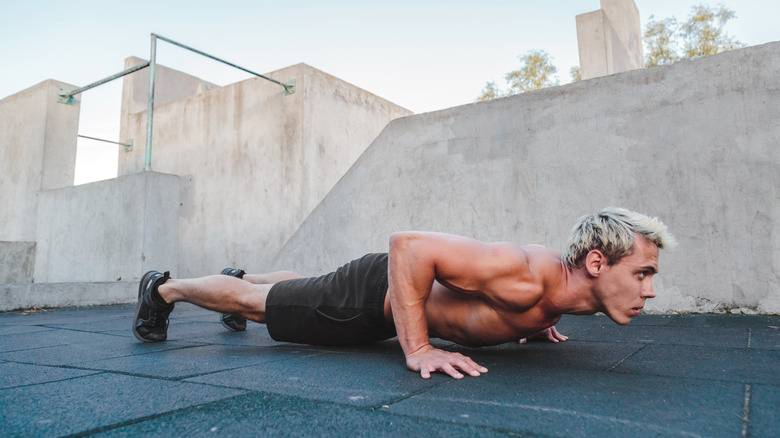When You Do Burpees Every Day, This Is What Happens
It's hard to think of an exercise more divisive than burpees. But love them or loathe them, burpees are here to stay, and not least because they're a killer move that, when performed correctly, can take your fitness game to the next level. "Burpees provide all sorts of benefits, as they are functional compound movements," states fitness guru Sultan Malik (via Aaptiv). Not only do they boost your coordination, states Malik, but burpees can also "increase cardiovascular-pulmonary functionality as well as power and muscular endurance." In layman's terms, that all means that burpees are gonna do you a whole lot of good.
For this reason, burpees are a staple of HIIT workouts, while fitness challenges featuring daily burpees have exploded in popularity. Some people have taken their burpee game pretty seriously, with CrossFit athlete Nick Anapolsky setting the Guinness World Record in 2021 for the most burpees done in an hour — an eye-watering 879. But whether you want to smash a record of your own, or are simply looking to get a little more fitness into your life, what actually happens when you do burpees every day? Join us as we jump, tuck, and plank our way to the facts.
Daily burpees could improve cardiovascular health
That chest-pounding, blood-pumping sensation you feel when you do a run of burpees every day? That's largely due to the efficient activation of your cardiovascular system. Over time, daily burpees could help to strengthen it. When you're doing burpees, "the heart and lungs are forced to work more efficiently to supply energy to the body," states cardiologist and Upper East Side Cardiology founder Satjit Bhusri to Well+Good. Bhusri states that "studies have shown that a higher number of burpees in [a three-minute interval] indicates higher cardiorespiratory fitness, which is associated with reduced risk for heart disease," as well as a reduced risk of coronary artery disease.
If you're not a huge fan of burpees, don't worry, as there are plenty of other cardio exercises that you can do to improve your heart and cardiovascular health. John Hopkins exercise physiologist Kerry J. Stewart recommends regular aerobic exercise, like swimming, running, cycling, or brisk walking, to help benefit your cardiovascular system. Other types of exercise, like resistance training and stretching, can have secondary effects benefits for your heart and the overall efficacy of cardiovascular function (per John Hopkins Medicine).
You might end up with stronger bones
It's not just your muscles that burpees will strengthen. A set of burpees every day could also help to make your skeleton stronger by increasing your bone mineral density. As VeryWell Fit states, there's a known link between exercise and increased bone health and density. Namely, exercises that put consistent force on a bone help to stimulate new bone growth. In addition to weight training, VeryWell Fit also points out that bodyweight exercises and jumping exercises (being high-impact exercises) are also beneficial on this front. So, if your burpees include a hop at the top, you and your bones could be in luck.
HIIT training has also been shown to help increase bone mineral density, as seen in a study from the Journal of Physical Education and Sport. Researchers followed a group of participants who took part in a HIIT training program for eight weeks and found higher levels of bone mineral density in that group at the end of the period. So, given that burpees are a common part of a HIIT rotation, including this high-impact exercise as part of a daily workout could help boost your bone strength.
You put yourself at greater risk of a wrist injury
As an exercise, burpees put a lot of force on your wrists. Unfortunately, there can be too much of a good thing, as daily burpees could increase your likelihood of sustaining a wrist injury. According to certified strength and conditioning specialist Bill Hartman, burpees can put particular stress on your scapholunate ligaments (per Men's Health). Injury to this ligament, which is essential for proper wrist function, can occur when stress is placed on the hand or when the wrist is bent too far backward, according to the American Society for Surgery of the Hand — like if you're a little too vigorous with your burpee movements.
If you're noticing pain when you bend your wrist backward, limited movement in the wrist, bruising, or pain or swelling around the wrist, then it could be a sign of just such an injury. If you're prone to wrist injuries, keep things slow and controlled when coming onto the floor for burpees. You could also try this modification, recommended by Aaptiv trainer and Trainers in Transit owner Jennifer Giamo (per Aaptiv). "While in the push-up position of this movement, instead of [laying your] hands flat on the floor, make a fist," Giamo says, noting this reduces stress on the wrist joint. Incline burpees, which place less stress on the wrist, are also an option.
Your mental health could improve
Okay, we realize that the suggestion that arduous daily burpees will boost your meed might raise some eyebrows, but hear us out. Numerous studies have cited the positive effects of exercise on mental health. One review of studies published in Psychiatria Polska notes that, regardless of gender or age, regular exercise shows improvements in mental states in a wide range of people. The review also notes that immediately post-exercise, symptoms of anxiety and depression can be reduced.
It all comes down to those sweet, sweet endorphins. As you exercise, your body releases endorphins, chemicals that work with your brain receptors to reduce pain perception and increase a sense of positivity, states WebMD. These interactions are responsible for giving you that sense of wellbeing and happiness both immediately after an exercise session and, with regular exercise, in the long term. As WebMD notes, exercising for 20-30 minutes three times a week can help you reap rewards for your mental health. Exercising a little more (4-5 times per week) can be even more beneficial. But if you're just starting out, make sure not to jump into any exercise regime too intensely, taking it slow at first.
Your ab strength will improve — if you do them correctly
While the high involvement of our arms and legs during burpees can lead to some serious limb toning, burpees are full-body exercises, meaning loads of muscles come to the party. These include your abs — thanks to the raised plank portion of a burpee, your abdominal muscles can see some great gains by doing burpees every day, according to Coach. However, as with all exercise, form is everything. When you're in the plank position, make sure your core is engaged and contracted, and that your back isn't arching. Failure to maintain this form can not only reduce the stimulation your abs get, but it can also increase your risk of injury.
If you're doing burpees to target your abs specifically, there are plenty of variations out there that can fire up your stomach. One of them, from certified strength and conditioning specialist Ebenezer Samuel, combines a burpee and a sit-up for an ab blitz that you'll be feeling for days afterward (per Men's Health). When you come into the raised plank of a burpee, lower yourself completely to the floor and roll over onto your back. Then, perform a sit-up with your arms raised above your head. Once you've completed the sit-up, roll back onto your stomach, push up into the plank again, and complete the burpee.
You might see your running performance improve
Doing burpees every day won't just help you to do more burpees. It could also potentially allow you to see improvements when doing other forms of exercise. Let's take running as an example. As health coach and NYC-based certified personal trainer Melissa Chisholm tells Byrdie, burpees are a full-body exercise that provide great benefits to leg strength. If you're a runner, incorporating strength-training exercise sessions just a few times a week can help increase performance, particularly during middle- and long-distance running events, as a study from Sports Medicine found.
While the study doesn't discuss doing burpees for running performance specifically, it does show that greater leg strength can help runners. Also, the added benefit that burpees have as a cardiovascular exercise can help to bolster improvements to cardiovascular health that you might see when running regularly. If you really want to tailor your daily burpees to level up your running game, certified personal trainer Mike Donavanik recommended five burpee variations to Runner's World that can help to get miles under your belt even faster.
You could be at risk of overtraining
Embarking into a regimen of daily burpees is an admirable move, but in practice, it could be harder than you think. And when it comes to any exercise, if you're doing it too much, the downsides can start to outweigh the benefits. According to a study conducted by Pennsylvania State University's associate professor of kinesiology Jinger Gottschall in combination with fitness company Les Mills, excessive HIIT training can lead to overtraining and compromised performance (via Sustain Health). As burpees are a staple of many HIIT workouts, it's hard to discount their potential to hinder your exercise progress if you overdo them.
Overtraining isn't pretty. As NYC-based certified strength and conditioning specialist Alissa Rumsey says to Shape, overtraining can result in "a decrease in performance, injuries, pain that won't go away, sleep disturbances, missed menstrual periods (which is associated with bone loss), depression, and anxiety." In short, it's always important to listen to your body when it comes to exercise. If you're noticing any of these symptoms in tandem with pounding out daily burpees, it might be time to rest and scale back.
You'll gain muscle strength all over your body
Fancy getting more toned all over? Daily burpees could help with that. When performed correctly, regular burpees are a sure-fire way to help strengthen muscles all over your body, including those in your shoulders, arms, chest, legs, hips, glutes, and abdominals, as Healthline states. Not bad for one exercise.
In fact, burpees are arguably one of the most efficient calisthenics exercises out there. Calisthenics is a form of working out that uses your body weight for resistance to build strength and endurance. While bodyweight exercises are often ignored for strength in favor of throwing around (or responsibly lifting, we hope) heavy weights in the gym, it's one of the oldest forms of exercise out there. In fact, it's been used by everybody from ancient Greek exercisers to modern-day athletes and military personnel, says Healthline. Studies, like one published in Isokinetics and Exercise Science, have shown that a program of calisthenics training can be effective for the improvement of body composition, strength, and endurance, as well as helping to improve posture.
Daily burpees can improve your mobility
If you're looking to exercise to increase your overall mobility, there may be a good reason to include a set of burpees in your everyday fitness routine. As Livestrong indicates, burpees work quite well as mobility training, given that it is an exercise that follows the natural ranges of motion in the body.
It can be the case, however, that burpees can be made more difficult to perform if you have mobility issues. That's especially true if you have limited mobility in your groin (for when you're performing the squat aspect of the move) or in your chest and shoulders (during the press-up part). If you're finding this to be the case, it can be useful to perform additional stretches that can help you to increase your range of motion in these parts of the body, like a lateral squat stretch for your groin or a lying pectoral stretch for your chest. Additionally, if you have limited mobility, there are burpee variations that you can perform that won't be as taxing as the full-out version. As Men's Health states, box burpees and beginner burpees are both great forms of this exercise that allow you to work with a smaller range of motion and potentially build your way up to the full movement.
You could increase your risk of lower back injury
Although your lower back doesn't have any floor contact during a regular burpee, it still gets a lot of action during this type of exercise. And if you're not doing burpees with the correct form, your risk of lower back injury can be much higher. The place where this is most likely to happen, according to certified strength and conditioning specialist Mark DiSalvo, is during the transition between the low squat and high plank stages of a burpee (per SELF). At this point, as people move their legs to the rear, they can allow their hips to droop towards the floor. This can place stress on the lower back, increasing the likelihood of injury.
So, how do you keep this from happening? The key here is core strength. To keep your hips in proper alignment, your core muscles, especially your anterior core muscles (which surround your lower stomach, helping to provide stability to your spine and hips), must be strong enough to support the weight of your hips and back. If you're feeling the strain in your lower back, it might be useful to spend some time focusing on core strength. Try out these lower ab workouts from Men's Health that could help keep your burpees stable.
You'll burn calories faster than other exercises
Why are burpees such a favorite of trainers around the world? Believe it or not, they're not just trying to cause you abject pain during your workout. Instead, many trainers know that the exercise can provide huge energy-expending benefits. "Burpees are fantastic calorie burners," says fitness coach Ally McKinney to Insider. "As your muscles are lengthening and extending through your burpee reps, they require lots of energy to make that happen."
In fact, the energy required is way more than many other exercises, hence their efficiency. A study published in the Journal of Strength & Conditioning Research found that body-weight burpees, along with battling rope exercises, placed higher metabolic demands on the body than other traditional resistance exercises like push-ups and planks. This means that you're expending more calories to do burpees, while your heart rate's shooting up during it. So, next time your HIIT instructor says the dreaded "B" word, have faith that they're doing it for your benefit!
Your lungs may get more efficient
When we exercise, we often focus on the changes to our exterior appearance. But regular exercise, including burpees, helps to benefit a plethora of internal things, too. Our lungs can get in on these positives when doing anaerobic exercises like burpees every day, especially as part of a HIIT rotation. When we exercise, our muscles require more oxygen, so our lungs and heart have to work harder to move oxygen around (per the American Lung Association). As you get fitter, your lungs and heart get stronger, with your body getting more efficient at getting the oxygen where it needs to be.
When part of a high-intensity training workout, burpees can take your lung strength up a notch while saving time. The European Journal of Applied Physiology looked at the effects of different types of training, HIIT training and endurance training (or ET). The study's authors concluded that HIIT training could strengthen respiratory muscles and aerobic performance in a more time-efficient manner than ET.
You'll improve your immune system
Noticing that you're feeling a little run down recently? It could be worth thinking about your exercise frequency and whether you could squeeze some time in for some daily burpees, as the practice may help you increase your immunity. While regular exercise can be highly effective in reducing the risk of long-term illnesses like heart disease, it can also serve in the fight against seasonal baddies like colds or the flu, according to MedlinePlus. While there's no set consensus on exactly how exercise helps to prevent seasonal illnesses, one reason could be the spike in the circulation of antibodies and white blood cells around our bodies that occurs during and after exercise.
In addition to other seasonal illnesses, strengthening the immune system could help to prep it more readily against respiratory viruses, namely COVID-19 infection, according to Clinical and Experimental Medicine. The review's authors recommend "regular practice of adequate intensity" exercise to serve as an additional tool to help strengthen the immune system against COVID-19, although the authors do point out that additional studies are needed to better establish the link between physical exercise and COVID-19 infection.
You could start to experience knee pain
Burpees get your knees moving pretty seriously. If you're doing this exercise every day, it's important to stay aware of any knee pain that occurs during or after your workout. According to Larson Sports and Orthopedics, burpees can put a significant strain on your knee joints, with conditions like loosened cartilage or meniscus tears occurring as potential injuries and complications. If this happens, you'll likely know right away, thanks to signs like a popping or crunching sound in the knee (yikes!), swelling and pain, and a limited range of motion in the joint. However, as Larson Sports and Orthopedics points out, meniscus or cartilage injuries can also occur with little to no symptoms outside of exercise.
If you're worried about your knees during burpees, the first thing to remember is it's not a competition to see how many you can do or how quickly you can get them done (despite some fitness challenges saying as such). "The movement doesn't need to be fast to be effective," states the American Council on Exercise's senior advisor Pete McCall to Livestrong. So, slow down to reduce any risk of injury through jerky knee action. You can also try out a variation using an elevated surface (like a box or exercise bench) to place your hands on when you come into the plank. That'll help reduce strain on your knees.















